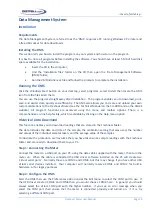
...the
art
of
distell
‐
ing...
Freshness
Meter
User
Manual
Page
15
Usage
recommendations
Using
the
meter
in
quality
control
Sampling
The
Fish
Freshness
Meter
was
designed
with
the
needs
of
the
quality
controller
in
mind.
The
term
‘quality
controller’
is
meant
to
include
officials
responsible
for
public
health
inspection
or
enforcement
of
mandatory
regulations
concerning
quality,
as
well
as
persons
concerned
with
quality
control
in
industry
and
commerce.
In
a
typical
situation,
a
controller
is
required
to
test
batches
of
fish
that
are
being
inspected,
sold
or
processed
as
a
unit,
and
for
this
a
suitable
sample
must
be
taken.
The
meter
simplifies
this
process
of
assessing
a
batch
by
sampling.
If
the
freshness
of
individual
fish
within
a
batch
is
measured
with
the
meter,
it
will
be
found
to
vary.
This
fish
‐
to
‐
fish
variation
in
meter
readings
is
caused
by
two
factors:
‐
a.
Variation
in
intrinsic
freshness
among
individual
fish.
b.
Variation
of
meter
readings
among
fish
of
the
same
freshness.
Both
are
expressions
of
the
variability
of
biological
organisms.
A
batch
of
fish
caught
at
the
same
time
and
handled
and
stored
identically
will
spoil
at
slightly
different
rates
because
of
variations
in
chemical
constitution
and
bacterial
activity.
Hence
the
individual
fish
in
the
batch
will
have
a
range
of
freshness;
a
range
that
will
tend
to
increase
as
spoilage
increases.
The
meter
readings
themselves
are
not
direct
measures
of
freshness,
as
defined
in
sensory
terms,
but
are
strongly
associated
with
it.
The
relationship
between
meter
readings
and
freshness
as
measured
by
a
sensory
panel
will
once
again
be
different
for
each
individual
fish.
For
this
reason
it
is
not
recommended
that
the
meter
be
used
to
assess
the
freshness
of
single
fish,
except
within
rather
wide
limits.
These
deviations
from
average
behaviour
tend
to
cancel
out
when
the
means
of
samples
from
batches
are
taken,
and
the
bigger
the
sample
the
better
the
correlation
between
the
mean
meter
reading
and
freshness
score.
It
follows
from
sampling
theory
that
the
number
of
fish
which
ought
to
be
sampled
from
a
batch
depends
mainly
on
the
desired
precision
of
the
mean
score.
It
also
follows
that,
provided
the
batch
is
large
enough,
the
required
sample
size
does
not
depend
on
the
size
of
the
batch.
From
observations
made,
it
has
been
decided
to
use
a
sample
size
of
eight
fish
as
the
basis
for
the
averaging
in
the
Fish
Freshness
Meter.
In
most
marketing
and
distribution
systems
the
fish
are
held
in
containers
with
a
capacity
of
50Kg.
Several
containers
constitute
a
batch.
In
this
situation
fish
from
as
many
containers
as
possible
should
be
sampled
i.e.
one
from
each
container
if
the
batch
has
eight
or
more,
four
from
each
container
if
that
is
all
there
is
in
the
batch.
If
the
controller
or
inspector
wants
greater
confidence
in
the
batch
average,
more
than
one
set
of
eight
fish
can
be
sampled,
and
a
grand
average
of
the
results
calculated.
Note
that
the
precision
of
an
averaged
result
increases
only
as
the
square
root
of
the
sample
size.
An
average
of
64
readings
is
only
twice
as
precise
as
an
average
of
8
readings.
Freshness
Meter
performance
The
relationship
between
meter
readings
and
other
measures
of
freshness
There
are
many
ways
of
expressing
the
freshness
of
fish.
Perhaps
the
simplest
for
fish
held
in
ice
is
to
quote
the
storage
time.
However,
as
is
well
known,
the
initial
quality
of
many
species
of
fish
varies
with
the
seasons
of
the
year,
due
to
such
factors
as
the
spawning
cycle
and
the
availability
of
food.
These
factors
also
affect
the
rate
of
spoilage,
so
that
the
time
in
ice
is
not
necessarily
a
good
measure
of
















































